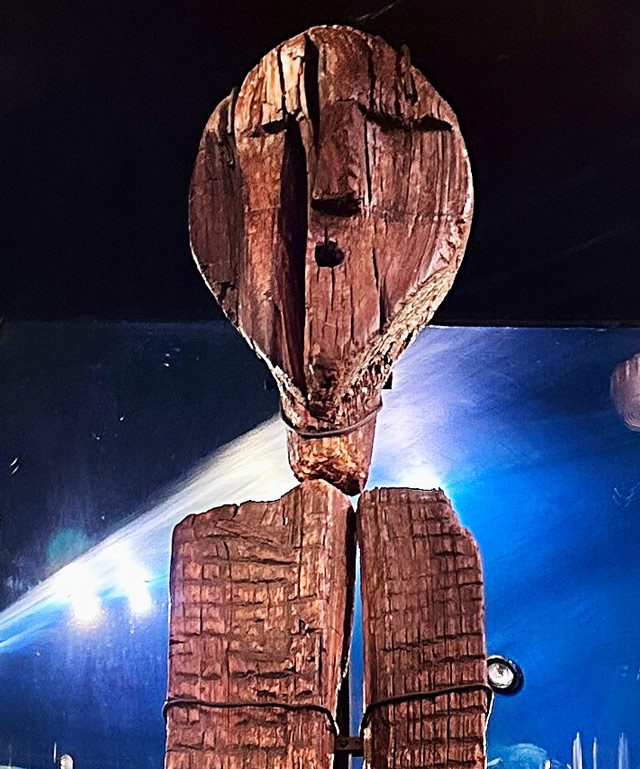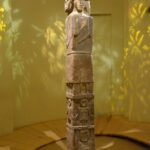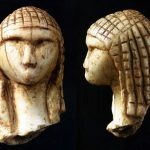
If there’s one thing that sends historians and archaeologists buzzing with excitement, it’s an ancient artifact that refuses to give up all its secrets. That’s precisely the case with the Shigir Idol—the world’s oldest wooden sculpture, dating back over 12,000 years. Discovered in the Ural Mountains of Russia in 1890, the Shigir Idol continues to intrigue and mystify experts, and its cryptic carvings only add layers to the puzzle. The age, size, and peculiar carvings make this artifact both a scientific marvel and a riddle waiting to be solved.
So, what makes this artifact so captivating? Let’s dig deeper into the fascinating enigma that is the Shigir Idol, from its origins and possible meanings to the ongoing debates around it.
The Astonishing Discovery of the Shigir Idol
Imagine this: It’s 1890, and workers digging in a peat bog near Kirovgrad, in Russia’s Ural Mountains, stumble upon something extraordinary. A fragment of a wooden sculpture, tall and carved with what appear to be geometric symbols, emerges from the ground. Initially, it didn’t seem like much. But as the pieces were put together—literally and figuratively—archaeologists quickly realized they were dealing with something special.
The Shigir Idol, once fully assembled, measured a staggering 5.3 meters tall. It is made of larch, a type of tree that was prevalent in the region at the time. The peat bog, with its low-oxygen environment, preserved the wood impeccably, allowing researchers to study the artifact in a near-pristine state.
How Old Is It?
At first, scientists speculated that the Shigir Idol was around 9,000 years old. For its time, this was already impressive. However, advances in radiocarbon dating technology in the 21st century shattered that assumption. A team from Germany’s Göttingen University analyzed the wood, concluding that the Shigir Idol is, in fact, about 12,100 years old, making it older than Stonehenge, the Egyptian pyramids, and even the earliest written texts.
The updated age shifted perspectives drastically. This wasn’t just a relic from some lost civilization—it was one of the earliest examples of human artistic expression. The age alone put it in the spotlight, but the mystery surrounding its intricate carvings keeps it there.
The Cryptic Carvings: What Do They Mean?
If you’ve ever looked at the Shigir Idol, you’d probably notice the strange carvings etched across its surface. They are geometric in nature—zigzags, straight lines, herringbone patterns—but they also depict faces, which only deepens the mystery. What could these symbols represent? Experts have proposed several theories, each as intriguing as the next.
Spiritual or Religious Symbolism?
One popular hypothesis is that the Shigir Idol was some form of spiritual or religious totem. The carvings may represent spirits or gods, a common theme in many ancient cultures. The faces could symbolize deities or ancestors, while the geometric patterns might signify the cosmos or natural forces. Given its age, the Idol could offer a rare glimpse into early human spiritual practices. Could the people who created the Shigir Idol have believed it held protective powers? Or maybe it was used in rituals to communicate with the divine?
Archaeologist Mikhail Zhilin of the Russian Academy of Sciences has supported this theory, suggesting that the Idol was “a repository of encoded information about the mythology of its creators, a marker of their worldview.” This interpretation aligns with how other ancient cultures used similar art forms to connect with the divine.
An Ancient Map?
Another tantalizing theory is that the Shigir Idol might be some sort of map or guide. The carvings could correspond to geographic features, offering insight into the land around the Ural Mountains. This would make the Idol a type of prehistoric navigation tool. The intricate lines could represent rivers, mountain ranges, or even migration routes. The faces might mark sacred or significant locations.
Of course, without a Rosetta Stone for the Shigir Idol, this theory remains speculative. But the notion that ancient humans were sophisticated enough to create symbolic maps opens up a whole new avenue of exploration.
A Message from an Ancient Civilization?
What if the Shigir Idol is an ancient message left by a civilization we know almost nothing about? If we think of the carvings as a form of early writing or coding, then the possibilities expand. Could it be that the creators were trying to communicate something to future generations—or even to other civilizations? The repeated patterns might represent a primitive language or system of symbols that modern archaeologists haven’t yet cracked. This idea gains more weight when we consider that the Idol predates known written languages by several thousand years.
But if it is a message, what could it say? Perhaps it’s a warning, a story, or a set of instructions. Until we can decipher it, the Shigir Idol will continue to be one of the most compelling mysteries in archaeology.
The Significance of the Idol’s Faces
The Shigir Idol’s most arresting feature is undoubtedly its faces. There are at least eight distinct human-like faces carved along its length. These are not simple etchings; they are detailed and expressive, featuring deep eyes and pronounced noses. Each face seems to stare out, hauntingly watching over time itself.
A Look into Early Human Artistry
One of the most fascinating things about these faces is that they challenge our understanding of early human artistic abilities. Scholars previously believed that such detailed human representation didn’t emerge until much later in human history. But the Shigir Idol turns that assumption on its head. The faces show not just skill but intentionality, suggesting the carvers had a sophisticated understanding of human anatomy and expression.
Some researchers believe these faces might represent the creators’ ancestors or revered figures in their community. Others think they could be depictions of spirits or gods, offering a visual connection between the physical and spiritual worlds.
The Role of Shamanism
Another theory proposes that the faces on the Shigir Idol may be connected to shamanistic practices. In many ancient cultures, shamans acted as intermediaries between the human and spirit worlds. The faces could represent spirits summoned by shamans during rituals, or they could be protective spirits intended to ward off danger.
This idea dovetails with the spiritual interpretation of the Idol, reinforcing the notion that the Shigir Idol was far more than just an artistic creation—it was a sacred object with deep cultural significance.
The Shigir Idol and Its Relation to Other Ancient Art
While the Shigir Idol is unique in many ways, it’s also part of a broader tradition of prehistoric art. Its discovery adds another piece to the puzzle of how ancient humans expressed themselves artistically and spiritually. Let’s look at how it compares to other well-known ancient artworks.
Older Than the Pyramids
To put the Shigir Idol’s age into perspective, it is thousands of years older than the Pyramids of Giza or even the Great Sphinx. The craftsmanship seen in the Idol suggests that even in the Late Upper Paleolithic period, humans were capable of creating complex, meaningful art. This flies in the face of the once-popular notion that early humans were only concerned with survival.
The Shigir Idol shows that humans from this era had a sophisticated understanding of their environment and spiritual beliefs. Whether it served as a religious object, a map, or something else entirely, its creation required planning, skill, and a deeper understanding of the world.
Comparisons with Gobekli Tepe
The mysterious carvings on the Shigir Idol have often drawn comparisons to Gobekli Tepe in modern-day Turkey. Gobekli Tepe, another ancient site with complex carvings, is thought to be one of the earliest known temples, dating back roughly 11,000 years. While the two sites are geographically distant, they share common elements. Both represent ancient societies with advanced artistic abilities and potentially spiritual beliefs far more developed than we once thought possible for these early cultures.
Could the Shigir Idol represent a parallel development of complex societies across different parts of the world? Or is it evidence that humans were already connected in some way? These questions add to the allure of the Idol.
Why Does the Shigir Idol Continue to Mystify Experts?
One might think that, after over a century of study, the Shigir Idol would have revealed most of its secrets. However, the truth is that we still know relatively little about it. What continues to baffle experts is how such an advanced object was created at a time when humans were still presumed to be living in small, nomadic groups focused on survival.
Lack of Comparable Artifacts
One of the primary reasons the Shigir Idol remains an enigma is the lack of similar artifacts from that period. Most wooden artifacts from prehistory have not survived, as wood decays easily over time. The Shigir Idol was only preserved because of the unique conditions of the peat bog. This scarcity of comparable artifacts makes it challenging to place the Idol within a broader context.
A Window into a Lost World
The Idol offers a rare glimpse into a world that we know almost nothing about. The people who carved it left no other known traces of their civilization. There are no written records, no buildings, and no other significant artistic remains. The Shigir Idol stands alone as a testament to their existence, their creativity, and their worldview. For archaeologists, this is both frustrating and tantalizing. Without more artifacts to study, they are left to speculate on who these people were and how they lived.
An Ongoing Puzzle
Despite numerous studies and analyses, the meaning of the Shigir Idol’s carvings remains a mystery. Some experts believe we are missing a crucial piece of the puzzle—whether it’s a cultural context, a Rosetta Stone-style discovery, or something else entirely. Until then, the Shigir Idol will continue to intrigue, mystify, and inspire those who study it.
The Shigir Idol’s Place in Modern Archaeology
The Shigir Idol has become a symbol of how much we still have to learn about early human history. Its discovery and subsequent studies have changed the way archaeologists think about prehistoric art and human development. Far from being simple hunter-gatherers focused solely on survival, the people who created the Shigir Idol were clearly capable of complex thought, artistic expression, and perhaps even spiritual reflection.
Challenging Old Assumptions
Before the discovery of the Shigir Idol, most historians and archaeologists believed that early humans didn’t engage in artistic practices until much later in history. The Idol challenges this assumption and forces us to reconsider the timeline of human artistic and cultural development.
A Living Mystery
While the Shigir Idol may be ancient, it remains a living mystery in the sense that new discoveries about it are still being made. Every new study, every new theory brings us a little closer to understanding the people who created this remarkable artifact. But for now, the Shigir Idol continues to guard its secrets, standing as a silent witness to a world long gone.
A Mystery Still Waiting to Be Solved
In the end, the Shigir Idol is not just an ancient artifact—it’s a question posed to modern humanity. What were its creators trying to tell us, and why does it feel like their message is just beyond our grasp? Whether it was a spiritual object, a map, or a message from a lost civilization, one thing is certain: the Shigir Idol reminds us that there is still so much we don’t know about our own history.
So, the next time you find yourself thinking about the mysteries of the past, remember the Shigir Idol—a puzzle carved in wood, standing tall in its silence, waiting for us to decode its ancient secrets.




